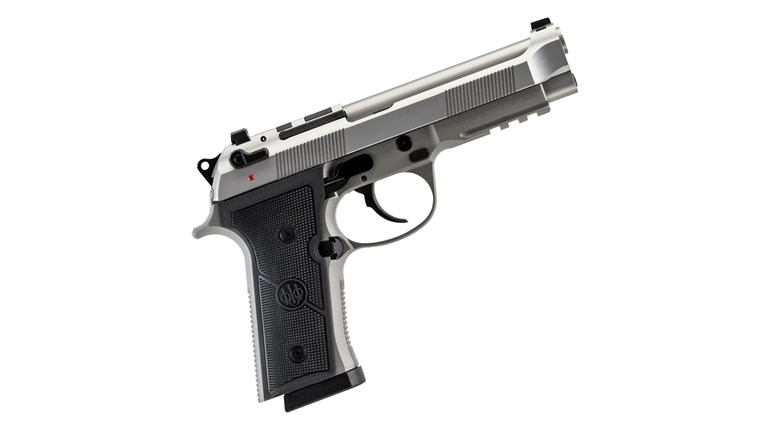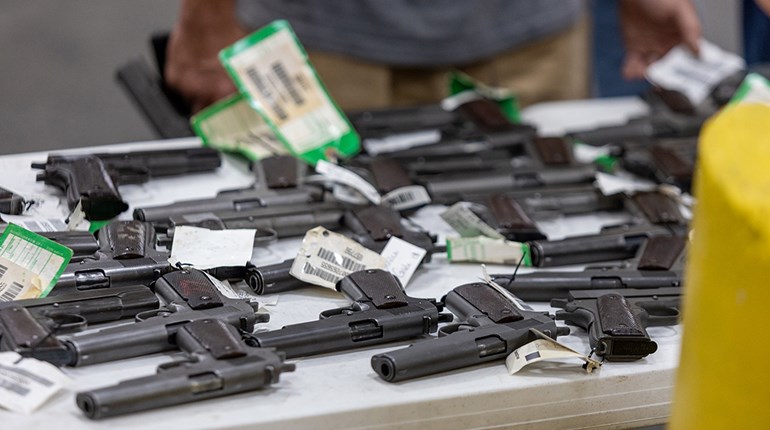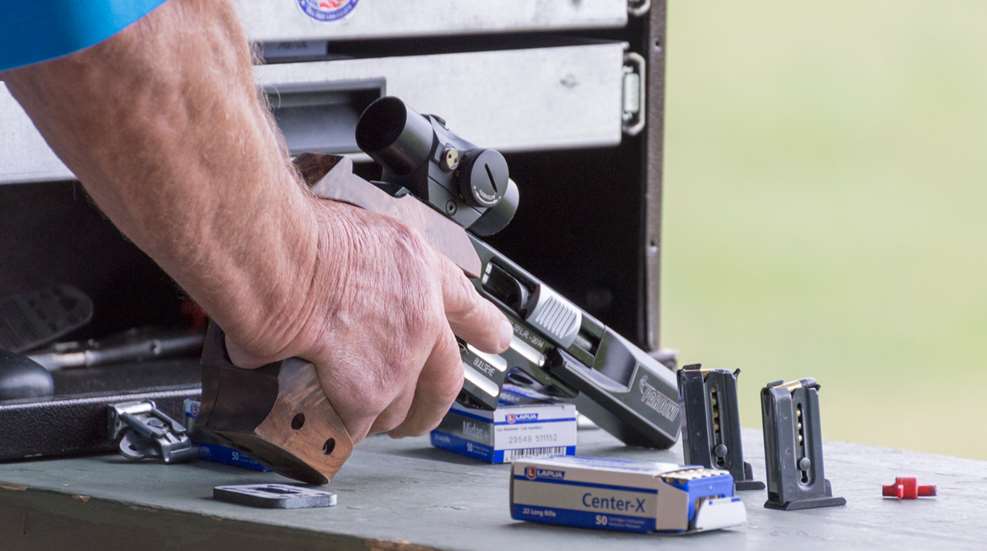
In his latest article for SSUSA, twelve-time NRA National Pistol Champion Brian Zins shares his thoughts on anticipation in conventional pistol competition. Zin’s insights are especially valuable because he doesn't always follow the old traditions with his technique. Readers may also want to read his previous articles on trigger control, proper pistol grip and aiming the red dot sight.
Yes, everybody. In some form or another practically every bad shot that was not a grip or position issue was a form of anticipation. Jerking the trigger is in essence anticipation, bucking, heeling and flinching. All of these are forms of anticipation.
The problem is I don’t feel anyone has truly addressed the issue of how to correct it. Similar to a lot of things when it comes to shooting pistol, coaches could tell you what you were doing wrong. They could even show you what you were doing wrong. Remember the “Ball and Dummy drill?” Put a dummy round mixed in with the live rounds and show the shooter that they are jerking the trigger or anticipating the recoil. I remember that one, I absolutely hated it and think that there is no place on the range for it. The shooter would see the sights go away and the coach would say, “See, you were jerking the trigger,” usually followed with, “Don’t do that!” Well thanks genius!
It doesn’t take long to figure out that if you are jerking the trigger, heeling, flinching, bucking or closing your eyes and you are aware of it, that obviously you aren’t doing it on purpose. So how do you stop? That’s where we seem to lose a lot of coaches. They can identify problems, but cannot fix them.
Imagine this hypothetical scenario: Your mechanic tells you the Flux Capacitor on your car is broken. However, the mechanic admits that he doesn’t know where it is, or even how to fix it—if he could find it. Would you go back to that mechanic?
There is a solution to identify a lot of these problems prior to them becoming shots in places we don’t want them to be. Welcome the Shot Process into your life. Get to know it and make it your own little Shot Process and raise it however you see fit. After all, it is your Shot Process to cultivate and modify as you wish. If only children were that easy, but what fun would that be?
The Shot Process is your mental plan and checklist that ensures that you are doing everything the same every time in order to shoot tens. Everyone has shot a ten at some point. A ten that you shoot is no different than a ten that Jimmy Henderson, Steve Reiter, Phil Hemphill or myself shoots. The difference is that we shoot more tens because we have a routine that we follow every time the gun leaves the bench.
A lot of good shooters that took a long time to get good may not believe this. They may say they never developed a Shot Process, and they are just good. Well, the fact of the matter is that they did develop a routine and process over time, without really knowing it. What you need to do is actively develop that plan. Why would you wait and allow it to happen over thousands and thousands of rounds, when you can be in control of the development and tweak the plan as you need?
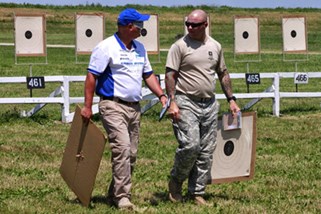 I have heard good shooters describe their Shot Process as, “Pick gun up, shoot gun, put gun down.” While it is frustrating to hear a good shooter say that, that is practically my Shot Process now. I have been developing this process for 20 years, and currently still am. In the beginning, my Shot Process was long. I was told to write down everything I did in order to shoot one ten. Everything from the time I put the gun on the bench, until the gun went into recoil. Just the part from loading the gun until the gun went bang filled one side of a piece of paper.
I have heard good shooters describe their Shot Process as, “Pick gun up, shoot gun, put gun down.” While it is frustrating to hear a good shooter say that, that is practically my Shot Process now. I have been developing this process for 20 years, and currently still am. In the beginning, my Shot Process was long. I was told to write down everything I did in order to shoot one ten. Everything from the time I put the gun on the bench, until the gun went into recoil. Just the part from loading the gun until the gun went bang filled one side of a piece of paper.
Everything that I had to do in order to shoot a ten needed to be confirmed that it was correct. I would dry fire and ensure that everything felt good from feet, hips, shoulders, grip, and trigger feel. Also, I confirmed the stage of fire I was about to shoot so I knew whether I was going to shoot slow fire, timed or rapid. You have got to put to paper everything you need to do to shoot a ten.
Some of them might include the following: How many shots you dry fire in slow fire, timed and rapid fire? How many breaths do you take before raising the gun? When do you breathe before raising the gun? Do you inhale the gun up and exhale to settle into the black or vice versa? NOTE: you really should inhale on the way up and exhale to settle into the aiming area.
What are you looking at? Irons, the dot, the target if shooting a dot maybe? Do you talk to yourself as the gun comes up? What do you say? Is it a phrase or key word? Is it the same thing for all three stages of fire? It really should be, or at least really close. What is your visual focus on as the gun is raised? Are you looking at the front sight or are you looking at the firing pin?
Did you straighten your arm prior to raising the gun or did you just hap-hazzardly throw it up in the direction of the target? When the gun settled in the aiming area was it acceptable or did you just figure that you could move your arm at the shoulder or adjust the gun in your grip to get the sights where you want them to be? Was the grip proper when you dry fired or did you do something to screw it up when you chambered a round?
All of these questions and more need to be addressed in your Shot Process.
The best way to learn this process is to have a partner there to write down everything you do and are thinking so that you do not take any short cuts. That is the easy part if you are honest with yourself and actually write down everything you do to shoot one well aimed shot. The hard part is following that process and being able to identify when you are not, or identify problems in the process and abort the shot in slow fire or fix it, expediently, in timed and rapid fire. You have to be aware of all these steps and be honest with yourself and stop and fix them. If you think in slow fire that you can muscle through an indicator and still make a good shot then I am here to tell you that if it does end up being a good shot, you got lucky. I can’t tell you how many times I thought, “I can still shoot this and make it a ten.” Almost every time I didn’t shoot a 100 slow fire, there was that shot.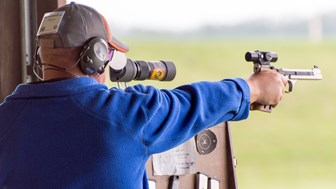
What can make a real difference is the ability to identify indicators earlier in the process. Most of us at some point have been able to call a shot, and say where the shot went before scoping because you saw something happen as the shot broke. What you need to realize is that most of the time there was an indicator earlier in the process that was trying to tell you it was going to be a bad shot. What happens is we do not pay attention to them, and keep squeezing the trigger thinking that it will fix itself. Most of my shots that I abort are aborted before the gun settles into the aiming area. Thus, you can see that early in my process there is an indicator that tells me DO NOT let this shot go, without fixing something.
Remember your training partner that helped write down your process? Now, use them to ensure that you are in fact following that process that you developed. Eventually, they will become subconscious acts. You will not have to ask yourself all these questions before each slow fire shot and each string of timed and rapid fire, your process will take over and you will automatically be able to identify the imperfections in all the steps and nuances of your process—without asking yourself the questions. Perhaps you will even reach the, “pick gun up, shoot gun, put gun down” Shot Process. Therefore, by utilizing proper trigger control and aiming, and by following the Shot Process that you have developed for yourself, you can eliminate a lot of issues, including anticipation.
For more pistol competition tips from Brian Zins, or if you are interested in his training classes, please visit his web site: www.brianzins.com.














